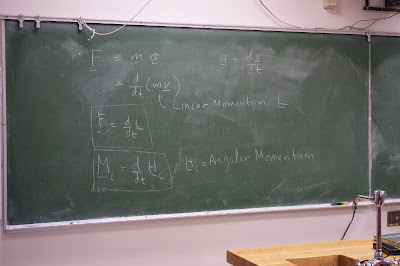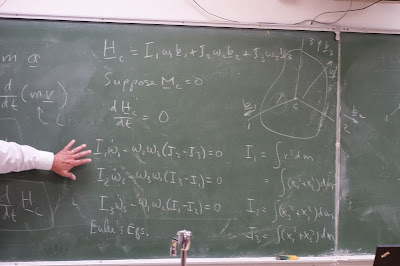Dr. Lewis Mingori from UCLA talked about spinning satellites for the Physics/Astronomy lunch lecture series.
Prof. Mingori #UCLA is talking about spinning space vehicles for #AmericanRiverCollege Physics series pic.twitter.com/NXPlaOJvlQ
— Ken Kubo (@kmkubo) October 2, 2013
Wow, a full house for Prof. Mingori #UCLA talking today at #AmericanRiverCollege about spinning spacecraft pic.twitter.com/oSi2mR3GPUProf. Mingori is also Megan Prout's uncle! Megan is an officer in the ARC Research Club, which sponsored this talk.
— Ken Kubo (@kmkubo) October 2, 2013
Prof. Mingori discussed a remarkable time in U.S. space history that resulted from the successful 1957 launch of Sputnik 1. The U.S. needed to respond to the USSR space technology success, so the Explorer 1 spacecraft was rushed to the launch pad.
The Explorer 1 satellite successfully launched into Earth orbit on January 31, 1958.
Source: JPL photo number 293-3466
Source JPL photo number P-8485
But once in Earth orbit, Explorer 1 didn't behave as expected. In NASA's history of Explorer 1:
The satellite's spin-stabilized attitude transitioned into a minimum kinetic energy state, that of a flat spin about its transverse axis. This was deduced from the modulation of the received signal, which produced periodic fade-outs of the signal.
This is another explanation of what happened from The Village Elliot:
They wanted the satellite to be cigar shaped to fit on the rocket, but in earth orbit they wanted to stabilize it by letting it rotate like a spinning top. But once they launched the satellite, it didn't rotate like they wanted it to, and within hours it was in a flat spin.
Why didn't Explorer I stabilize properly? Well the mathematicians went back and reviewed what they were doing. It's sort of like the kid's trick, of spinning an egg like a top. If you have a hard boiled egg, it behaves like a rigid body, and you can stabilize it by spinning it on the pointy end. But an uncooked egg cannot be spun this way, not at all. It winds up lying on its "side" which is the most stable configuration (i.e., it can not fall over once it is lying on its side. The mathematicians had treated Explorer I as if it were a perfectly rigid body, suitable to be stabilized around its "minor axis" or the centerline as it sat on the launch padA spinning stick demonstrates the windmill spin that Explorer 1 exhibited.
Since I'm a biotechnology instructor, this is how I visualize the Explorer 1 flat spin in lab.
Prof Mingori shows how a spacecraft can spin by using a book.
In 1997 NASA Jet Propulsion Laboratory (JPL) created an animation showing Explorer 1 in Earth orbit. Do you see the Explorer 1 windmill spin?
The JPL has more Explorer 1 videos.
With more knowledge and math (see below), NASA, newly formed at the time, launched a better designed spinning spacecraft, Pioneer 1, in October 1958.
During the talk, Prof Mingori shared a large dose of math to explain the dynamics of spinning spacecraft.

Physics/Astronomy lunch talk w/ Prof. Mingori #UCLA: you can't escape #math cc @profbrandonm pic.twitter.com/SKWXV2tHtB
— Ken Kubo (@kmkubo) October 2, 2013

















Great stuff! Thanks for sharing Ken
ReplyDelete